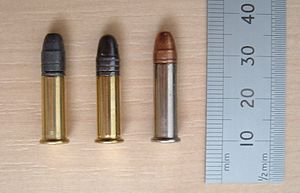
Back .22 Long Rifle Byelorussian .22 Long Rifle BE-X-OLD .22 Long Rifle Breton .22 LR Catalan .22 Long Rifle Czech Long rifle Danish .22 lfB German .22 Long Rifle Spanish کالیبر ۲۲ خفیف Persian .22 LR Finnish
| .22 long rifle | ||||||||||||||||||||||||
|---|---|---|---|---|---|---|---|---|---|---|---|---|---|---|---|---|---|---|---|---|---|---|---|---|
 .22 long rifle cartridges. The one on the right is a hyper velocity "Stinger" with a longer case and lighter bullet. | ||||||||||||||||||||||||
| Type | Rifle | |||||||||||||||||||||||
| Place of origin | United States | |||||||||||||||||||||||
| Production history | ||||||||||||||||||||||||
| Designer | Union Metallic Cartridge Company | |||||||||||||||||||||||
| Designed | 1884 | |||||||||||||||||||||||
| Produced | 1884–present | |||||||||||||||||||||||
| Specifications | ||||||||||||||||||||||||
| Parent case | .22 long[1] | |||||||||||||||||||||||
| Case type | Rimmed, straight[1] | |||||||||||||||||||||||
| Bullet diameter | .223 in (5.7 mm) - .2255 in (5.73 mm)[1] | |||||||||||||||||||||||
| Land diameter | .212 in (5.4 mm) | |||||||||||||||||||||||
| Neck diameter | .226 in (5.7 mm)[1] | |||||||||||||||||||||||
| Base diameter | .226 in (5.7 mm)[1] | |||||||||||||||||||||||
| Rim diameter | .278 in (7.1 mm)[1] | |||||||||||||||||||||||
| Rim thickness | .043 in (1.1 mm)[1] | |||||||||||||||||||||||
| Case length | .613 in (15.6 mm)[1] | |||||||||||||||||||||||
| Overall length | 1.000 in (25.4 mm)[1] | |||||||||||||||||||||||
| Rifling twist | 1:16"[1] | |||||||||||||||||||||||
| Primer type | Rimfire[1] | |||||||||||||||||||||||
| Maximum pressure | 24,000 psi (170 MPa) | |||||||||||||||||||||||
| Ballistic performance | ||||||||||||||||||||||||
| ||||||||||||||||||||||||
| Test barrel length: 18.5 in (470 mm) Source(s): [2][3] | ||||||||||||||||||||||||
The .22 long rifle, also known as the .22 LR or 5.7×15mmR,[4][5] is a long-established variety of .22 caliber rimfire ammunition originating from the United States. It is used in a wide range of firearms including rifles, pistols, revolvers, and submachine guns.
In terms of units sold, it is by far the most common ammunition that is manufactured and sold in the world. Common uses include hunting and shooting sports. Ammunition produced in .22 long rifle is effective at short ranges, has little recoil, and is inexpensive to purchase. These qualities make it ideal for plinking and marksmanship training.
- ^ a b c d e f g h i j k SAAMI/ANZI. "American National Standard Z299.1-1992." SAAMI (Newtown, Connecticut USA) November 24, 1992.
- ^ a b c d "Federal Cartridge Co". Archived from the original on September 27, 2007. Retrieved September 25, 2007.
- ^ a b c Simpson, Rich. "Remove pesky rodents with sure-shot rimfire rifles". Times-News (Twin Falls, Idaho, USA) March 28, 2008.
- ^ Capt. Nick [Morton] (April 22, 2020). "Let's talk about … ammunition". Campbell College Combined Cadet Force. Archived from the original on March 28, 2023. Retrieved July 27, 2022.
- ^ Bartocci, Christopher R. (July 18, 2014). "Conversion in .22 Long Rifle for the Black Rifle: Part 1". SmallArmsReview. Archived from the original on September 21, 2021. Retrieved July 27, 2022.